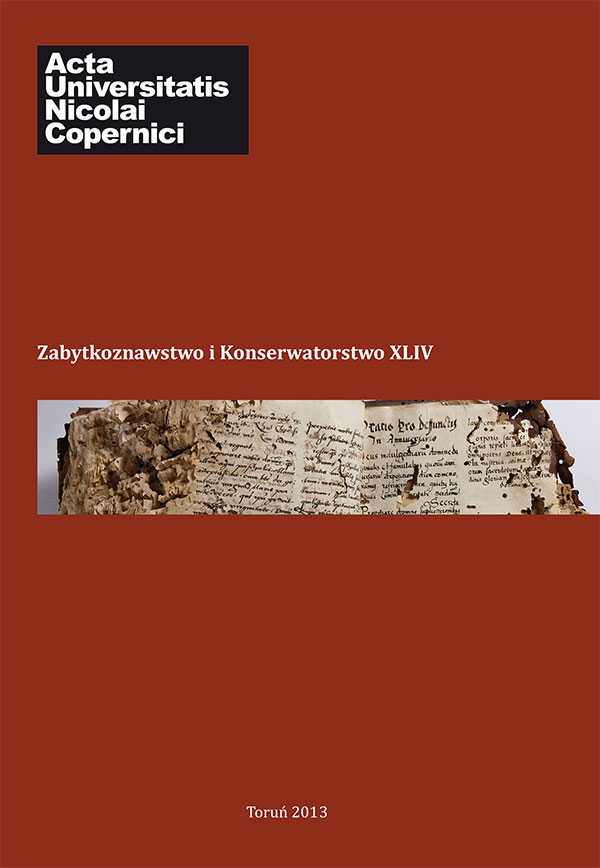Kaznodziejski potencjał malowidła w prezbiterium fary świętojańskiej w Toruniu. Treść i forma
DOI:
https://doi.org/10.12775/AUNC_ZiK.2013.004Słowa kluczowe
fara świętojańska w Toruniu, malarstwo świętojańskie, malarstwo średniowieczneAbstrakt
The theme of that study is a monumental mural painting on the north wall of the chancel of the former parish church of the Old Town in Toruń. In an unique way around the motif of Crucifixion concentrated are here numerous iconographic motifs of diverse origin: evangelic, old-testament, mystic and moralizing ones. Despite the abundant studies the detailed contents and form of that work have been so far only drafted. A discerning comparison of its potential with the structure, contents and social model of the mediaeval ars praedicandi proves, that it might have been serving as the preachers’ aid. Iconographic elements of the mural match the most important threads of mediaeval homiletics, and the moralizing message has been adjusted to the assumption of large-town sermons. Three-zoned structure of composition can be interpreted as three parts of the preachers’ dilatation, while the particular elements and their mutual relations make a four-step homiletic reasoning. Each of the zones has its own detailed development and uses a suggestive pictorial rhetoric of an emotive impact on the viewer. In visually the most interesting part – purgatory torments and the hell – the choice of stigmatised sins and individual attributes was addressed to the large-town auditorium, as was the Legend of the three living…being the warning against excessive passion for mundane goods in the spirit of the ad status preaching. The general message of that artwork seems to be obvious, while the proper reception and right interpretation of all it contents was possible only at the proper level of theological knowledge and erudition. The painting could have been a compendium, facilitating logical development of the contents of a sermon and building its general structure based on the tree-scheme. Particular elements could have been selected out of it and one could lead their exegesis in whichever direction, using whatever rhetoric for sermons suitable for various occasions.
The artistic language of that work reveals a Western provenance and is based on miniatures’ pattern. For general analogies for that complex composition one can search among the courtly pastoral codices made in France and England. General formal character as well as costume, arms and armoury features indicate inspirations with western painting of the first half of 14th century. Interpretation of style is hindered by extensive overpainting and reintegration, but assuming those features as dating ones, one should abandon the so far dating of the work to the last quarter of 14th century and set it in times about 1350. Exclusive language of western forms can also be interpreted in aspect of the preachers’ ad status rhetoric. In absence of written sources that would allow for a thorough recognition of the scope and contents of sermons in the Monastic State of Teutonic Order, the role of that painting as a source material can hardly be overestimated.
Pobrania
Opublikowane
Jak cytować
Numer
Dział
Licencja
CC BY-ND 4.0. Posiadaczem prawa autorskiego (Licencjodawcą) jest Autor, który na mocy umowy licencyjnej udziela nieodpłatnie prawa do eksploatacji dzieła na polach wskazanych w umowie.
- Licencjodawca udziela Licencjobiorcy licencji niewyłącznej na korzystanie z Utworu/przedmiotu prawa pokrewnego w następujących polach eksploatacji: a) utrwalanie Utworu/przedmiotu prawa pokrewnego; b) reprodukowanie (zwielokrotnienie) Utworu/przedmiotu prawa pokrewnego drukiem i techniką cyfrową (e-book, audiobook); c) wprowadzania do obrotu egzemplarzy zwielokrotnionego Utworu/przedmiotu prawa pokrewnego; d) wprowadzenie Utworu/przedmiotu prawa pokrewnego do pamięci komputera; e) rozpowszechnianie utworu w wersji elektronicznej w formule open access na licencji Creative Commons (CC BY-ND 4.0) poprzez platformę cyfrową Wydawnictwa Naukowego UMK oraz repozytorium UMK.
- Korzystanie przez Licencjobiorcę z utrwalonego Utworu ww. polach nie jest ograniczone czasowo ilościowo i terytorialnie.
- Licencjodawca udziela Licencjobiorcy licencji do Utworu/przedmiotu prawa pokrewnego nieodpłatnie na czas nieokreślony
PEŁEN TEKST UMOWY LICENCYJNEJ >>
Statystyki
Liczba wyświetleń i pobrań: 866
Liczba cytowań: 0



